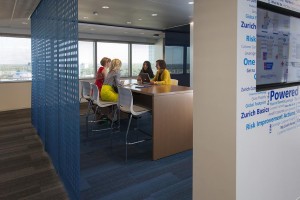There’s no more critical asset to an organization than its people.
The collective talents, efforts and ambition of a company’s employees defines its ability to achieve business goals. More and more, leadership is taking an active role in leveraging workplaces to impact recruitment and retention by creating offices that address employee needs and satisfaction while making it as easy as possible for people to do their jobs.
At the forefront of this charge are workplace pilots – rapid prototypes allowing employees to experience possible future workplace settings and share qualitative and quantitative feedback to inform future decision-making.
3 ways to empower people – and the business
Companies that invest in workplace pilots decrease the risk of creating spaces that fail to align company culture, business goals, work styles and the work environment. Instead, they best position themselves to create rewarding environments that empower people and business.
One current example of workplace piloting is Zurich Insurance Group’s extensive efforts in advance of its new 750,000 sf suburban Chicago North American headquarters set to open in Fall 2016. Determined to engage its people in the creation of the new workplace that will drive success for decades to come, Zurich has built an extensive program with multiple prototypes that more than 150 employees will test over the next three months.
Here are three key pieces companies need to get right in order to structure a successful workplace pilot program.
1. Create the right prototype environments
In order for a workplace pilot program to be successful, company leadership must have a strong understanding of their organization and the type of work its people do.
For example, global companies demanding collaboration must incorporate the type of high-technology environments that empower such work. Smaller regional organizations may not require such a focus on collaboration but need to balance private work spaces with teaming areas.

Ultimately, the only way to ensure a pilot program leads to the optimal work environment is to define clear objectives and goals and develop prototypes that test within those relative parameters.
Given Zurich’s reputation as a leader in global risk management it must achieve a highly balanced environment that creates opportunities for individuals to work distraction-free or connect to other teams around the world. As a result, the four prototype work neighborhoods are each well-balanced but to different degrees.
This guidance from Zurich’s leadership ensures the pilot program is testing the right scenarios to drive success in the long-term.
“We want to ensure that we are creating the right design to meet employee needs enabling them to be effective and productive,” says Jennifer Kyung, Headquarters Business Lead. “We committed to engaging with our employees on the design from the beginning knowing that highly engaged employees lead to better results.”
2. Offer multiple options
Pilot programs need to present employees with a wide range of options in the prototype environments. Programs that test just a few variables limit the level of feedback the organization can derive from its employees.
Zurich’s program is robust in that it offers four unique possible work environments that different groups will each experience for three weeks at a time. Within each environment are more than 22 different seating options and configurations along with unique groupings of workstations, informal meeting areas, conference rooms, enclaves, social hubs and private offices.
Such an extensive plan will truly allow employees to fully understand the different prototypes and offer relevant feedback for three key reasons:
- Time –– Zurich’s pilot program is not limited by only asking employees to test certain new environments for a day or a week. With 12 weeks total and three weeks in each prototype environment, the employees will literally live, eat and work in these environments and fully understand how they do or don’t work for them.
- Depth of testing — The pilot program is not solely focused on ultimately selecting one of the four environments and running with it. Employees are experiencing different workspace arrangements, informal seating options and private areas within each environment as well. Zurich is looking for feedback on everything and fully cognizant of the fact the ideal work environment may be a hybrid of current prototypes.
- Work is getting done — Often, pilot programs fall short in that they ask employees to test different environments where they can’t actually get work done. At Zurich, all the necessary technology, communication and printing tools are incorporated into the design to allow employees to still be productive and fully experience what it’s like to work in the prototypes.
3. Listen — before, during and after
The fuel that powers successful pilot programs is employee feedback. Leadership must take the time to collect the thoughts and ideas of its employees experiencing the prototype environments.

Even before our team began working with Zurich, the company formed employee work streams to inform all the potential environments, was scheduling Town Hall meetings and performing surveys to truly understand how its employees needed to work. All of that research informed the creation of the pilot program.
“Zurich’s goal is to build a world-class headquarters while keeping our focus on employee health and wellness,” said Kyung. “With over 75 percent of our initial surveys returned, a focus group dedicated to the workplace environment and this pilot program we are confident we will land on a result that empowers and engages our talented workforce to reach their fullest potential.”
Now, with the program in full swing, Zurich leaders continue to engage employees day-to-day, perform observation, scheduling focus groups and surveys at the completion of the program to ensure they obtain all necessary information to create a headquarters where its employees can be comfortable and productive.
Feedback pays off in the long-term
This commitment to feedback guarantees the hard work put in throughout the pilot program pays off in the long-term.
Across all industries, companies are continuing to place more importance on workplaces as tools to empower employees and improve recruitment and retention. As successful pilot programs like the one at Zurich continue to demonstrate, one of the best ways to do this is to design workplaces with employees and not just for them.
